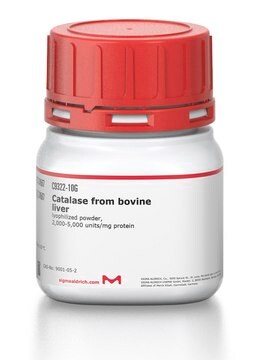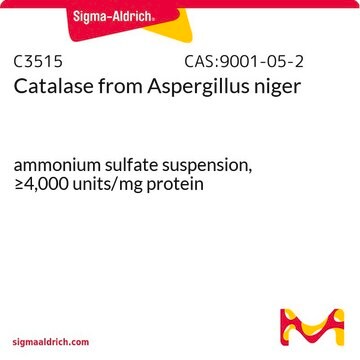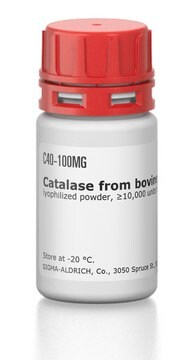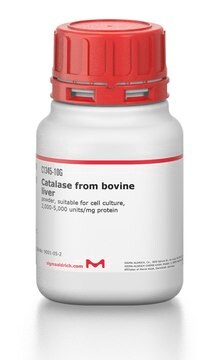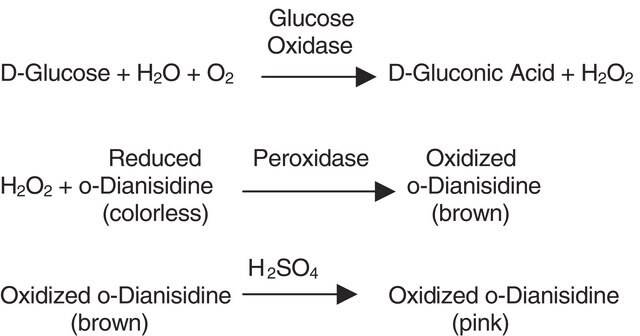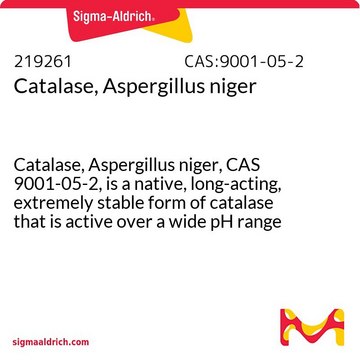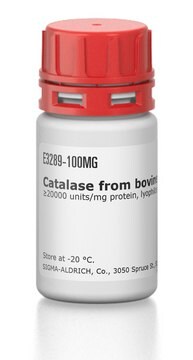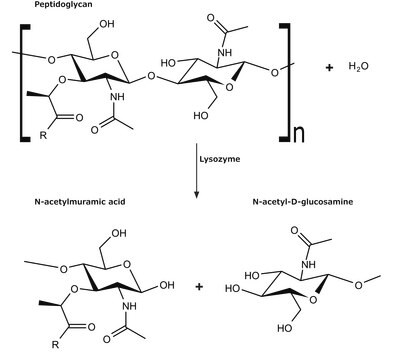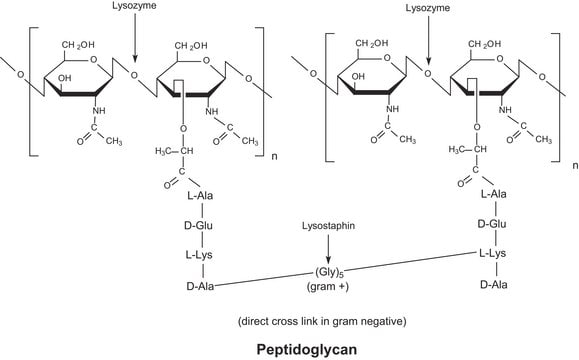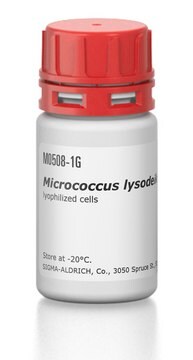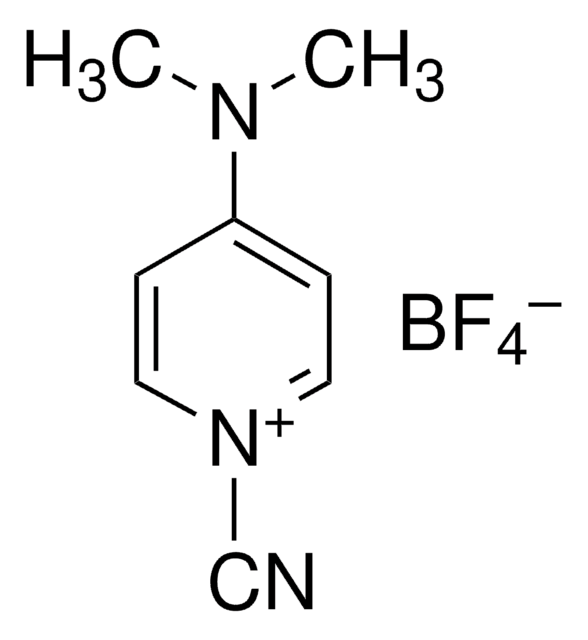60634
Catalase from Micrococcus lysodeikticus
solution, dark brown
Zaloguj sięWyświetlanie cen organizacyjnych i kontraktowych
About This Item
Polecane produkty
pochodzenie biologiczne
bacterial (Micrococcus lysodeikticus)
Poziom jakości
Formularz
solution
aktywność właściwa
65,000-150,000 U/mL
masa cząsteczkowa
Mr ~230000
metody
microbe id | metabolite detection: suitable
kolor
dark brown
rozpuszczalność
0.05 M phosphate buffer pH 7.0: soluble, clear, brown (1:10)
numer dostępu Protein ID
numer dostępu UniProt
Warunki transportu
wet ice
temp. przechowywania
2-8°C
ciąg SMILES
O(CC)C(=O)c1ccc(cc1)O
InChI
1S/C9H10O3/c1-2-12-9(11)7-3-5-8(10)6-4-7/h3-6,10H,2H2,1H3
Klucz InChI
NUVBSKCKDOMJSU-UHFFFAOYSA-N
Opis ogólny
Research area: Cell Signaling
Catalase (CAT) is an antioxidant enzyme, encoded by the CAT gene family. The enzyme is ubiquitously expressed in most of the aerobic organisms.
Catalase (CAT) is an antioxidant enzyme, encoded by the CAT gene family. The enzyme is ubiquitously expressed in most of the aerobic organisms.
Zastosowanie
Catalase from Micrococcus lysodeikticus has been used to eliminate excess of hydrogen peroxide production during sugar analog synthesis by in vitro biocatalytic cascade. It has also been used as a standard to evaluate oxidative stress by indirectly measuring catalytic activity.
Działania biochem./fizjol.
Catalase rapidly converts hydrogen peroxide to oxygen and water. It exhibits antioxidant activity and elicits a defense mechanism against reactive oxygen species (ROS). Catalase plays a role in neutralizing noxious hydrogen peroxide in nature as well as in various industries such as textile, pharma, and dairy. Micrococcus lysodeikticus catalase is a heme-containing protein.Catalase, along with various key cellular systems involved in hydrogen peroxide (H2O2) processing, plays a key role in regulating cellular redox balance and aids in cellular and intercellular signaling.
Definicja jednostki
1 U corresponds to the amount of enzyme which decomposes 1 μmol H2O2 per minute at pH 7.0 and 25 °C
Ta strona może zawierać tekst przetłumaczony maszynowo.
Hasło ostrzegawcze
Danger
Zwroty wskazujące rodzaj zagrożenia
Zwroty wskazujące środki ostrożności
Klasyfikacja zagrożeń
Resp. Sens. 1
Kod klasy składowania
10 - Combustible liquids
Klasa zagrożenia wodnego (WGK)
WGK 1
Temperatura zapłonu (°F)
Not applicable
Temperatura zapłonu (°C)
Not applicable
Środki ochrony indywidualnej
Eyeshields, Gloves
Wybierz jedną z najnowszych wersji:
Masz już ten produkt?
Dokumenty związane z niedawno zakupionymi produktami zostały zamieszczone w Bibliotece dokumentów.
Klienci oglądali również te produkty
Hessam Sepasi Tehrani et al.
Progress in biophysics and molecular biology, 140, 5-12 (2018-03-14)
Catalase is one of the firsts in every realm of biological sciences. At the same time it also has a number of unusual features. It has one of the highest turnover numbers of all enzymes. It is essential for neutralizing
Physiological mechanisms of adaptive developmental plasticity in Rana temporaria island populations.
Pablo Burraco et al.
BMC evolutionary biology, 17(1), 164-164 (2017-07-08)
Adaptive plasticity is essential for many species to cope with environmental heterogeneity. In particular, developmental plasticity allows organisms with complex life cycles to adaptively adjust the timing of ontogenetic switch points. Size at and time to metamorphosis are reliable fitness
Ivan Gomez-Mestre et al.
PloS one, 8(12), e84266-e84266 (2013-12-21)
Many amphibian species exploit temporary or even ephemeral aquatic habitats for reproduction by maximising larval growth under benign conditions but accelerating development to rapidly undergo metamorphosis when at risk of desiccation from pond drying. Here we determine mechanisms enabling developmental
Margarita Florencio et al.
Comparative biochemistry and physiology. Part A, Molecular & integrative physiology, 242, 110654-110654 (2020-01-12)
Organisms are exposed to multiple environmental factors simultaneously to which they often respond behaviorally, morphologically and/or physiologically. Amphibian larvae are quite plastic and efficiently adjust their phenotype and physiology to the reigning local conditions. Here we tested whether the combination
An improved procedure using ferricyanide for detecting catalase isozymes.
W Woodbury et al.
Analytical biochemistry, 44(1), 301-305 (1971-11-01)
Nasz zespół naukowców ma doświadczenie we wszystkich obszarach badań, w tym w naukach przyrodniczych, materiałoznawstwie, syntezie chemicznej, chromatografii, analityce i wielu innych dziedzinach.
Skontaktuj się z zespołem ds. pomocy technicznej